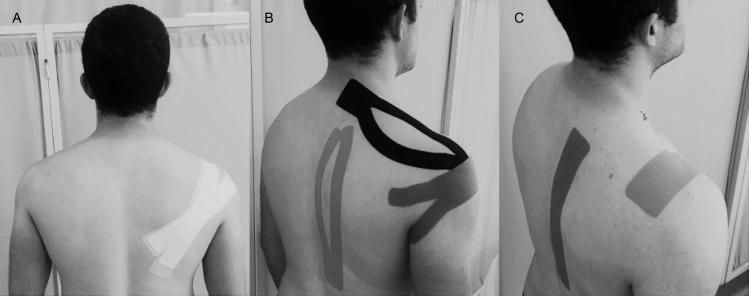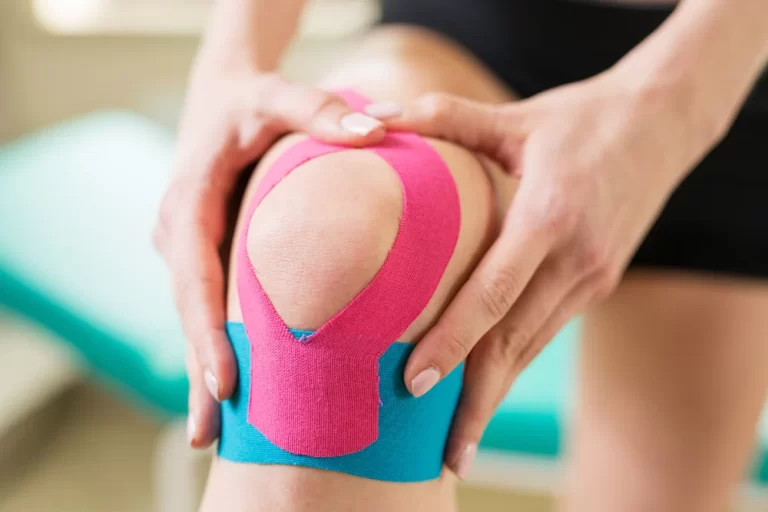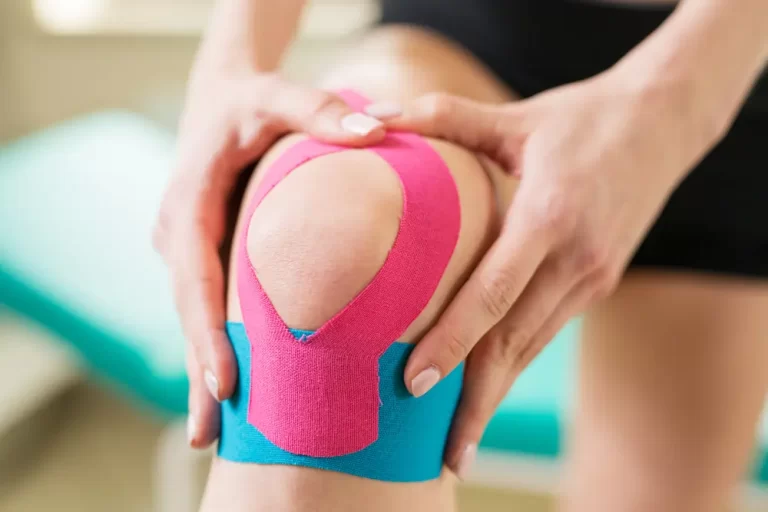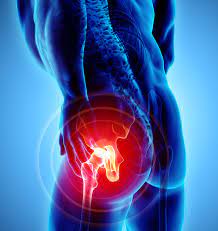Taping For Scapular Dyskinesia
Table of Contents
Introduction :
Kinesio or rigid taping for scapular dyskinesia is the most used technique. Kinesio or rigid taping of the scapular region as well as shoulder improved scapular dyskinesia and pectoralis minor length but did not alter scapular upward movement. Short-term Kinesio and Rigid taping may help to improve scapular dyskinesis and pectoralis minor length in overhead athletes.
This is the most effective and defensive treatment. kinesio taping gives static as well as dynamic support to the affected area of the scapular region. kinesio taping gives dynamic stability to the scapulas while typical taping gives static stability to the scapula.
it’s known as called kinesiology tape taping or kinesiology remedial taping. is an elastic cotton strip with an acrylic glue that is purported to ease pain and disability from athletic injuries and a variety of other physical conditions.
Kinesiological tapping could be a rehabilitative cum defending use of elastic kinesiological tapes to supply :
- reduction in scapular regional pain
- enhancing performance of scapula
- preventing any injuries to the scapular region
- support to the scapular region and scapular muscles
- relocating of scapular structure
- facial and ligamentous correction.
When your shoulder blades are not stable, you may experience a shoulder disorder called scapular dyskinesis. It’s characterized as losing a normal range of movement in your shoulder blades. In some cases, it’s a condition of its own.
Other times, scapular dyskinesis is a symptom of another health condition or any disease. Your shoulder blade is important for movement and range of movement in your shoulders.
Also called the scapula, your shoulder blades give stability to your rotator cuff. However, muscle, or bone around your shoulder, If you sustain an injury to your soft tissue. Scapular dyskinesis is easily identified because it causes your shoulder blades to stick out abnormally moreover during rest or activity.
Scapular dyskinesis is also called winging of the scapula because your shoulder blades stick out like wings on your back. Although the condition itself may not be painful, it can leave you at a higher threat of injury.
Scapular dyskinesia is changing in the position and scapular movements that predispose to shoulder injuries, as they modify the relationship of strength and tension of muscles and affect their effectiveness.
Scapular dyskinesia may be a consequence of multiple factors similar as biomechanical and physiological abnormalities, bone anatomy altered by posture or bone lesions, muscle injuries due to direct trauma, and microtraumas that lead to imbalances, fatigue, and pain.
Clinically relevant anatomy :
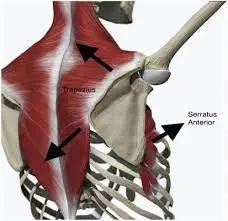
Typical movement of the scapula occurs in the sagittal, coronal, and transverse planes. The primary movements correspond to two translations superior/ inferior, and protraction/ retraction, as well as three rotations upward/ lowered, internal/ external, and anterior/ posterior.
Upward rotation is primary and posterior inclination secondary during normal overhead UE elevation with internal/ external rotation being minimum until 100 °.
“ SICK ” Scapula Syndrome refers to Scapular Malpositioning, Inferior medial border elevation, Coracoid pain, and malposition and DysKinesis of scapular movement. It’s an overuse Syndrome.
The scapula is protracted and is in an anteriorly inclined position secondary to the tight pec minor or short head of the biceps at the insertion into the coracoid process. Coracoid tenderheartedness is an important sign of scapular dysfunction, which is secondary to constant traction from tightness at the tendon’s insertion.
Dysrhythmia is defined as early or overmuch scapular elevation or shrugging on arm elevation and/ or a rapid-fire downcast rotation during arm lowering, or anon-smooth or stuttering movement during these actions.
Common signs and symptoms :
- Pain and or tenderness around the scapula when using the arm over the head or carrying heavy objects with the arm at the side.
- Snapping or popping sensation around the scapula with shoulder movements
- Loss of strength with shoulder and arm use.
- Asymmetrical posture( effected side generally sits lower)
- Winging of the scapula
- Insecurity of the shoulder( feels like it moves out of place)
Causes :
- Weakness in scapular muscles, imbalance, tightness, or( infrequently) detachment of the muscles that control the scapula
- Injuries to the nerves that supply the muscles
- Injuries to the bone that support the scapula or injuries within the shoulder joint
Contraindication of Kinesio or rigid tapping :
- Severe adverse responses to tape Kinesiology or rigid tape adheres to your skin. However, you should avoid using the tape, If you have a history of a severe adverse response to adhesives. generally, kinesiology or rigid tape is worn during athletic exercise, but it can also be worn for numerous days, and placing your skin in contact with adhesives for an extended period of time can lead to serious adverse responses.
- Open incisions If you have an open incision or surgical incision that is not completely healed, do not use kinesiology tape. The tape could produce a situation where bacteria is introduced into the incision.
- Presence of deep vein thrombosis( DVT) A deep vein thrombosis is a blood clot in one of the deep veins of the arm or leg. Using kinesiology tape near the deep vein thrombosis can increase mobility and blood inflow. This may produce the clot to come wedged and may put you at threat of a pulmonary embolism, which may be fatal.
- Infection If you are showing signs of infection, kinesiology tape should not be used, as it may worsen your condition.
- Altered sensation If you have uncontrolled diabetes, you may suffer from accessory neuropathy, a condition where you may have altered sensations in your legs or arms. Kinesiology tape shouldn’t be used if you have diabetes, since you may not know if the tape is causing a response or a problem with your skin. Other conditions that cause sensation loss, similar to strokes, may also be contraindicated for the same reason.
- Active cancer If you are presently witnessing treatment for cancer, you should avoid using kinesiology tape, since it’s allowed the tape to increase circulation, and adding blood flow and nutrition to a cancerous lesion may be dangerous.
Taping technique :
- Developed by. Kenzo Kase in 1979. The Kinesio Taping Method is the definitive rehabilitative taping system of knowledge and is designed to facilitate the body’s natural recovery process while providing support and stability to muscles and joints without restricting the body’s range of movement, as well as providing extended soft tissue manipulation to extend the benefits of manual therapy administered within the clinical setting.
- Latex-free and wearable for days at a time, Kinesio Taping is safe for populations ranging from pediatric to senior, and successfully treats a variety of orthopedic conditions, neuromuscular conditions, neurological conditions, and other medical conditions.
- The Kinesio Taping Method is a therapeutic taping technique not only offers you the support you’re looking for but also assists in the rehabilitation of injury and physiological dysfunction. Then we used two types of taping techniques. rigid taping and Kinesio taping.
- Rigid tapping is also known as athletic taping. Rigid tapping or Athletic taping is a temporary technique or an adjunct mechanism adopted as a measure of post-injury rehabilitation.
Application:
1) Rigid taping :
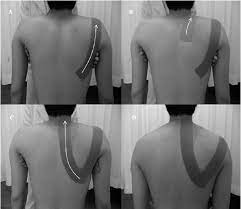
we applied standardized rigid tapping first hypoallergenic tape was applied with no tension. next, we applied the first rigid tape from the anterior aspect of the shoulder to the T6 area with pull-into retraction and the second rigid tape from just below the coracoid in the anterior aspect of the shoulder to the T10 area with an initial pull-up and then back.
2) Kinesio taping :
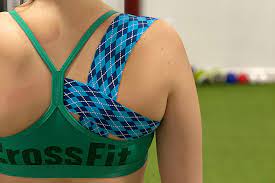
- We applied standardized therapeutic Kinesio taping. standard 5- cm Kinesio tape recording was used.
- first a Y- a strip measured the origin to the insertion of the supraspinatus using paper off pressure while participators reached behind their backs with their upper extremities and flexed their necks to the contralateral side second.
- we applied I- a strip from the coracoid process around the posterior deltoid using downward pressure and approximately 50 to 75 % stretch.
- initially, the shoulder was externally rotated with no elevation. Then it was moved into slight horizontal adduction and forward elevation as the end of the tape was applied with no stretch.
- this I-strip had a Y shape at the end of the tape. finally, we applied a y-strip from the T10-12 area lower trapezius muscle.
- for this technique, the lateral tail of the Y-tape was applied with the shoulder horizontally adducted, and the medial tail was applied with the crossed-over chest.
How to remove tape?
- When removing the tape, it is important to ensure you don’t just tear it off as you could damage your skin and cause irritation. To begin, ensure you are removing the product in the direction of your hair growth, to lessen any discomfort experienced.
- Ease it off carefully, folding the edge of the tape back slowly. Make sure to check that you’re peeling the removed tape back against the still-applied tape at an angle instead of just ripping it off.
- With your other hand, pull your skin taut and tug gently but firmly in the opposite direction of the applied tape, to assist in the separation of skin and tape and to ensure minimal discomfort.
- If you have not shaved before applying the tape and the area of the body you have treated has a lot of hair growth, it is a good idea to press down firmly on the tape as you are peeling it back, in order to reduce pain.
- Alternatively, you can apply an adhesive dissolving agent like baby oil, rubbing it in and leaving for approximately 5 minutes, before attempting to remove the tape slowly.
- This will lessen the stickiness and ensure a smooth removal, with no pain. Always use a product like baby or olive oil to remove Kinesio or rigid tape if you have sensitive skin or are prone to irritation.
- When you need to remove Kinesio or rigid tape, take care to pull it gently and at a slight angle, in the direction of any hair growth, pulling your skin taut with your other hand.
- Doing it this way will minimize any discomfort or pain and will ensure your skin is not listed as the tape is removed. You can encourage easier removal by stretching the skin behind the tape with a fingertip.
- When you need to remove Kinesio or rigid tape, take care to pull it gently and at a slight angle, in the direction of any hair growth, pulling your skin taut with your other hand.
- Doing it this way will minimize any discomfort or pain and will ensure your skin is not listed as the tape is removed. You can encourage easier removal by stretching the skin behind the tape with a fingertip. If you have sensitive skin or want an even gentler removal, cover the tape with a dissolving agent like olive oil or baby oil, leave for a few minutes, then ease the product off carefully.
FAQ
Is Kinesio tapping well for scapular dyskinesia?
Yes, Kinesio taping for scapular dyskinesia is a most used technique to relieve pain and more support to involve the area and help the further injury to the scapula or scapular muscles. This is the most effective and defensive treatment.
Why does Kinesio tapping work?
Kinesiology tape stabilizes the injured area by lightly adhering to the skin and applying pressure to the tissues the tape is wrapped around. This tape allows the connective tissue surrounding the affected muscle or tendon to move along with the body. means this tape gives dynamic stability to the affected area.
what are the five benefits of Kinesio taping?
1)decrease pain
2)increases circulation and decreases inflammation
3)improve the muscle support
4)improve athletic performance
5)supported endogenous analgesic systemHow long you can wear the tape on?
Once a physical therapist or sports medicine provider positions the tape, it can remain on the skin as long as the adhesive works, usually for two or three days. The adhesive is strong enough to withstand approved activities, showers, and daily life movements. Of course, if the adhesive causes itching, rash, or other types of discomfort, the tape should be removed.
Is rigid taping well for scapular dyskinesia?
Yes, Rigid tapping or Athletic taping is a temporary technique or an adjunct mechanism adopted as a measure of post-injury rehabilitation. The goals of the taping in sports are to restrict the motion of an injured joint, compress soft tissues to prevent swelling, support the anatomical structure involved in the injury, serve as a splint or to secure a splint, and secure the dressing and/or bandages, protect the injured part from re-injury and to protect the injured part while the healing process is under progress.

